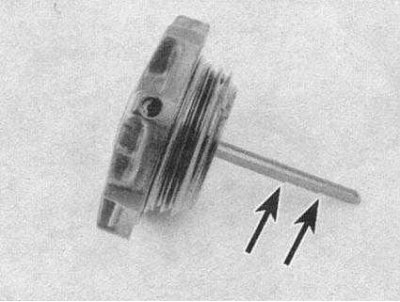Periodically check the fluid level in the power steering system to avoid driving problems such as damage to the steering pump. Proceed as follows.
Attention! Do not hold the steering wheel fully turned in either direction for more than five seconds. This can damage the steering pump.
On some models, the reservoir of the power steering system is located on the left side of the engine compartment and has a screw cap with a measuring probe built into it. On other models, a hydraulic booster system and a vacuum booster are used, having one common reservoir located in the right rear corner of the engine compartment.

Power steering fluid reservoir (indicated by an arrow) located on the left side of the engine compartment.
1. Park your vehicle on level ground and apply the parking brake.
2. On models with a built-in dipstick, start the engine and warm it up to normal temperature. With the engine idling, turn the steering wheel from lock to lock several times to purge air from the steering system. Stop the engine, remove the tank cap by turning it counterclockwise, wipe the dipstick dry and close the cap. Open the cap again and check the fluid level. It should be between two marks.

The fluid level of the power steering system must be maintained between the two arrows at the upper ledge of the dipstick.
3. On models with a hydraulic booster, depress the brake pedal ten times or until it begins to «resist». Loosen the nut, remove the cap and make sure that the liquid level is not lower than 6.0 mm from the top of the reservoir.
4. Add liquid in small doses until it reaches the desired level.

Adding fluid to the reservoir of the power steering system.
Attention! Do not overfill liquid. If this does happen, remove the excess with a clean syringe. Close the lid.
5. If frequent topping up is required, check power steering hoses and fittings for signs of wear and leaks (see Section Check of a condition and replacement of hoses of an impellent compartment).
6. Check the condition and tension of the drive belt (see Section Checking the condition, adjusting the tension and replacing the drive belts).